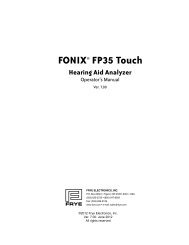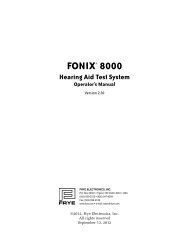Using the FONIX 7000 to Verify Coupler and Real-Ear Performance ...
Using the FONIX 7000 to Verify Coupler and Real-Ear Performance ...
Using the FONIX 7000 to Verify Coupler and Real-Ear Performance ...
You also want an ePaper? Increase the reach of your titles
YUMPU automatically turns print PDFs into web optimized ePapers that Google loves.
<strong>Real</strong> <strong>Ear</strong> Measurements 43<br />
6. Press [START] <strong>to</strong> measure <strong>the</strong> insertion gain of <strong>the</strong> hearing aid. Press [STOP] <strong>to</strong><br />
s<strong>to</strong>re <strong>the</strong> curve.<br />
7. Press [MENU] <strong>to</strong> open <strong>the</strong><br />
Insertion Gain Menu. Use <strong>the</strong><br />
up/down arrow <strong>to</strong> select <strong>the</strong><br />
Bias Tone option under <strong>the</strong><br />
Source heading <strong>and</strong> use <strong>the</strong><br />
right arrow <strong>to</strong> select a bias<br />
<strong>to</strong>ne level of 70 dB SPL.<br />
8. Press [EXIT] <strong>to</strong> return <strong>to</strong> <strong>the</strong><br />
test screen.<br />
9. Press [F2] <strong>to</strong> select <strong>the</strong> next<br />
curve.<br />
10. Use <strong>the</strong> right <strong>and</strong> left arrow<br />
keys <strong>to</strong> select <strong>the</strong> frequency of<br />
<strong>the</strong> bias <strong>to</strong>ne. Note <strong>the</strong> bias<br />
<strong>to</strong>ne frequency location, as<br />
indicated in <strong>the</strong> boxed section<br />
of Figure 55.<br />
Options for bias <strong>to</strong>ne frequency range from 200 <strong>to</strong> 8000 Hz in varying increments.<br />
11. Ensure that <strong>the</strong> signal amplitude is 65 dB SPL <strong>and</strong> <strong>the</strong> signal source is<br />
DigSpeech. Press [START] <strong>to</strong> begin <strong>the</strong> measurement.<br />
12. When <strong>the</strong> curve has stabilized press [STOP].<br />
Figure 57 – Insertion gain menu<br />
13. Use [F2] <strong>to</strong> select ano<strong>the</strong>r curve for testing at ano<strong>the</strong>r bias <strong>to</strong>ne frequency.<br />
14. Repeat steps 8 through 10 for testing at additional bias <strong>to</strong>ne frequencies,<br />
ensuring that <strong>the</strong> signal amplitude remains 65 dB SPL <strong>and</strong> <strong>the</strong> signal source<br />
remains digital speech.<br />
Note…The use of <strong>the</strong> continuous pure-<strong>to</strong>ne bias signal (available in 100 Hz increments) acting<br />
as a noise source presented simultaneously with <strong>the</strong> modulated speech composite signal allows<br />
<strong>the</strong> clinician <strong>to</strong> more effectively verify <strong>the</strong> effectiveness of <strong>the</strong> noise reduction feature of <strong>the</strong><br />
hearing aid in reducing <strong>the</strong> gain/output only in <strong>the</strong> frequency region surrounding <strong>the</strong> distracting<br />
noise while leaving intact <strong>the</strong> frequency region above <strong>and</strong> below <strong>the</strong> distracting noise. This,<br />
<strong>the</strong>oretically, would result in improved communication <strong>and</strong> comfort in noise because <strong>the</strong><br />
reduction in gain will be in a restricted segment of <strong>the</strong> frequency response instead of a larger<br />
segment of <strong>the</strong> frequency response in response <strong>to</strong> a noise. It is believed that hearing aids with<br />
greater channels of noise reduction could lead <strong>to</strong> better performance in noise (<strong>and</strong> feedback<br />
management) because in multichannel aids narrower <strong>and</strong> narrower segments of <strong>the</strong> frequency<br />
response are reduced in response <strong>to</strong> noise (or feedback) within <strong>the</strong> environment.<br />
Change <strong>to</strong><br />
70dB
















